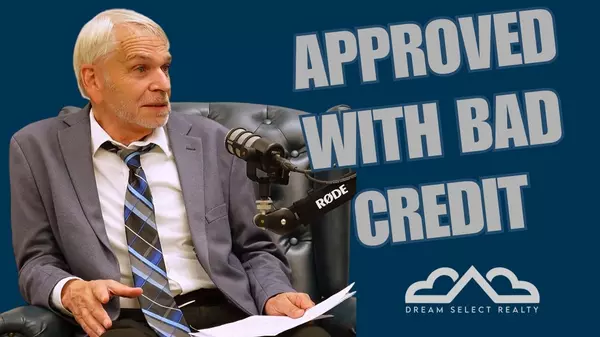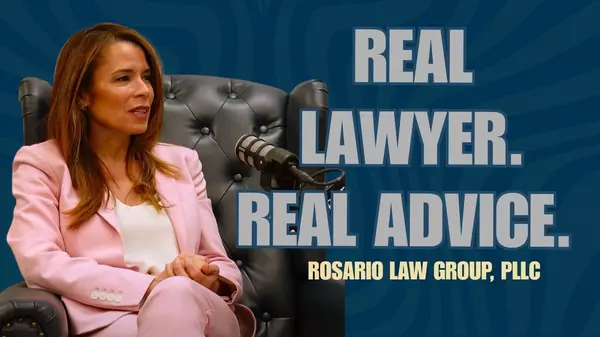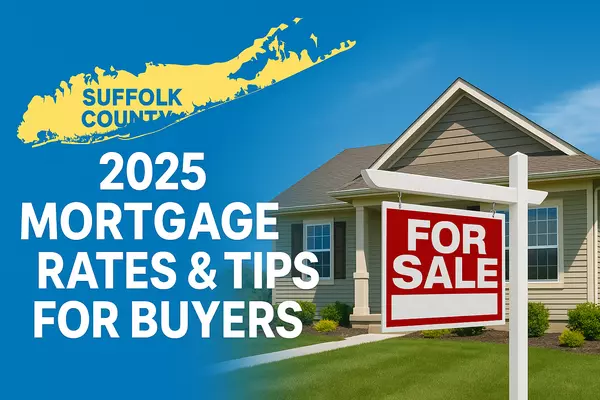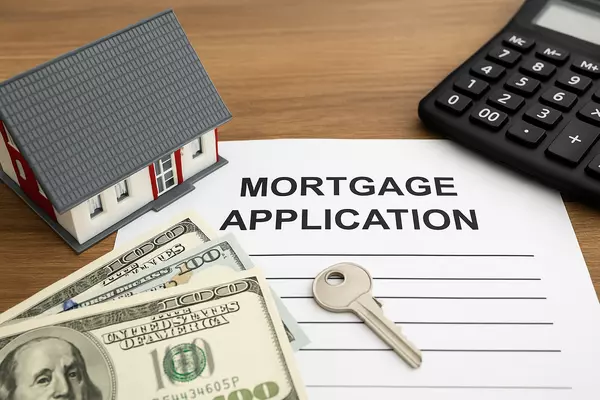Winning Strategies: Getting a Mortgage in Nassau vs. Suffolk

Welcome to Dream Select Realty’s deep dive into the Nassau and Suffolk mortgage landscape for 2025. Whether you’re a first-time homebuyer or a seasoned investor, staying informed about mortgages is essential for achieving your real estate goals on Long Island. The right loan can save you thousands of dollars over time, help you navigate the competitive market, and ease the process of homeownership.
In this article, we’ll explore:
- Interest Rate Trends Specific to Long Island
- New Loan Products for Nassau and Suffolk County Buyers
- Strategies for First-Time Homebuyers in both counties
(Note: This is a long read, designed to be thorough and helpful, especially if you’re looking for guidance in the ever-changing mortgage world. Feel free to bookmark it and return whenever you have questions!)
Interest Rate Trends Specific to Long Island
Overview of Mortgage Rates in 2025
In 2025, mortgage interest rates on Long Island generally hover in the mid-4% to low-5% range, though exact figures can change with the national economy and the Federal Reserve’s policies. These rates are somewhat higher than the historic lows of the early 2020s, but they remain favorable when looking at long-term trends spanning decades.
Why does this matter? Because your interest rate significantly affects your monthly mortgage payment. For example:
- At a 4.5% interest rate, a $400,000 mortgage might have a monthly payment around $2,000 (principal and interest, excluding taxes and insurance).
- At a 5.5% interest rate, that same loan could raise your monthly payment by a few hundred dollars.
But it’s not just about numbers. On Long Island, many factors shape local mortgage rates, including property taxes, home prices, and lender competition. Let’s break down why interest rates here may vary from national averages.
Local Economic Factors
- Proximity to New York City: Nassau County is closer to NYC, often attracting buyers who work in the city. High demand for homes near commuter rail stations can lead lenders to offer competitive rates, hoping to capture the wave of qualified borrowers. Suffolk County, while further out, has also been growing in popularity, especially as remote work increases.
- High Property Values: Long Island tends to have higher-than-average home prices compared to many other parts of the country. Mortgage lenders sometimes adjust rates or underwriting criteria to manage their risk in these high-cost areas.
- Tax Considerations: Property taxes in Nassau and Suffolk can be significant, influencing a buyer’s overall budget. Mortgage lenders sometimes factor in these taxes when assessing a buyer’s debt-to-income ratio.
The Federal Reserve’s Role
While local factors matter, the Federal Reserve sets the tone for interest rates nationwide. When the Fed raises the federal funds rate to curb inflation, mortgage interest rates often (but not always) rise. Conversely, if economic conditions soften, rates can dip as lenders seek to spur more borrowing. In 2025, experts predict moderate fluctuations, meaning rates might remain in a relatively stable band rather than spike dramatically.
Impact of Interest Rates on Buying Power
Buying power refers to how much house you can afford based on your monthly budget. When rates go up:
- Your monthly payment rises for the same loan amount.
- Some buyers may need to look at less expensive homes to stay within their monthly budget.
When rates go down:
- You can potentially afford a higher purchase price.
- Refinancing becomes more appealing, letting homeowners lower their payments or switch from a 30-year to a 15-year loan.
In Nassau and Suffolk Counties—where housing can be pricey—these changes have a noticeable impact. Even a 0.5% difference in your rate can affect your ability to qualify for a certain purchase price or comfortably manage monthly expenses.
How to Stay Informed About Rates
- Monitor the News: Financial news outlets track Fed decisions and economic indicators daily.
- Talk to Local Lenders: Lenders specializing in Long Island mortgages stay on top of regional rate shifts.
- Check with Your Agent: At Dream Select Realty, we have relationships with local lenders. We can help you get up-to-date rate quotes and clarify any changes in the market.
New Loan Products for Nassau and Suffolk County Buyers
Overview of Evolving Mortgage Products
Gone are the days when you had just two or three loan types to choose from. Today’s mortgage landscape is ever-evolving, with lenders launching new products designed to match changing consumer needs. In 2025, we see innovative loan products that cater to:
- First-Time Buyers struggling with down payments.
- Remote Workers who need flexible financing to accommodate dual home offices or multi-use spaces.
- Luxury Buyers looking to finance high-end properties with jumbo loans.
- Eco-Friendly Home Purchases that may qualify for green incentives.
Let’s break down some of the popular options available to Nassau and Suffolk buyers.
First-Time Homebuyer Loans
- FHA Loans (Federal Housing Administration): These loans remain a go-to choice for first-time buyers. They allow for down payments as low as 3.5%, which is helpful in high-cost areas like Long Island. Keep in mind, though, FHA loans come with mortgage insurance premiums (MIP) you’ll pay monthly.
- SONYMA Loans (State of New York Mortgage Agency): Specifically available to New York State residents, SONYMA programs can offer low-interest options, down payment assistance, and even closing cost help. This is particularly beneficial for buyers in Nassau and Suffolk who might need a financial boost to handle the region’s higher property prices.
- Community-Based Loans: Some local banks partner with community organizations to provide special loan programs. These might include reduced interest rates or forgivable second mortgages if you meet certain income limits or agree to stay in the home for a minimum time.
Jumbo Loans
Because many Long Island homes exceed conforming loan limits (which in 2025 are around the mid $700,000s in high-cost areas, though the exact figure can change annually), jumbo loans are common here. These loans cover amounts above the conforming limit, but often require:
- Higher Credit Scores (often 700+).
- Larger Down Payments (10–20% or more).
- Reserves: Lenders may require several months’ worth of mortgage payments in savings to ensure you can handle the larger loan.
If you’re eyeing a luxury property in Nassau or Suffolk—say in the Hamptons, or on the North Shore—this type of financing might be your go-to.
Renovation and Construction Loans
With older housing stock in many Nassau neighborhoods, renovation loans are becoming popular:
- FHA 203(k) Loans: Let you roll purchase and renovation costs into one mortgage, ideal if you buy a fixer-upper in Hempstead, Westbury, or other established areas.
- Homestyle Renovation Loans: A conventional alternative, it supports various upgrades and repairs, not limited to what an FHA loan allows.
- Construction-to-Permanent Loans: If you’re building a custom home on a Suffolk lot, this loan transitions from a construction loan to a standard mortgage once the house is complete.
Green Home Loans and Incentives
Eco-friendly homes with solar panels, insulation upgrades, or energy-efficient windows sometimes qualify for green mortgages. These might come with:
- Reduced Interest Rates for energy-saving improvements.
- Tax Credits for installing solar panels or geothermal systems (check local and state programs).
- Lender Rebates that reduce closing costs if you meet specific green-building criteria.
Given Long Island’s increasing focus on sustainability, it’s worth exploring these options if you plan to buy or upgrade an eco-friendly property.
Strategies for First-Time Homebuyers in Both Counties
Understanding the Challenges
Being a first-time buyer on Long Island can be daunting. Property prices in Nassau and Suffolk are often higher than the national average, and property taxes can be substantial. Limited inventory can spark bidding wars, especially for homes under $600,000. Because of these challenges, you’ll need a solid plan to successfully land your first home.
Saving for a Down Payment
- Aim for At Least 5–10% (or more if possible). While some loans allow a down payment as low as 3–3.5%, having more can lower your monthly payment and interest costs.
- Explore Assistance Programs: As mentioned, SONYMA and other grants can help cover a portion of your down payment or closing costs. Some towns even offer special assistance to encourage homeownership.
- Set Up a Dedicated Savings Account: Automate your savings to ensure you’re consistently building your down payment fund.
Pre-Approval and Budgeting
- Get Pre-Approved Early: This not only shows sellers you’re serious but also clarifies how much you can borrow.
- Calculate Your Full Housing Costs: Beyond principal and interest, budget for property taxes, homeowners insurance, and any applicable homeowner association (HOA) or condo fees.
- Leave Room for Upkeep: Single-family homes on Long Island can have higher maintenance costs (e.g., lawn care, snow removal, roof repairs), so factor that into your monthly budget.
Navigating a Competitive Market
- Be Flexible on Location: Expanding your search to less-famous neighborhoods could help you find a more affordable home.
- Make Strong Offers: If you find the right place, consider a competitive price, a clean offer (fewer contingencies), or a personal letter to the seller—though letter effectiveness varies by situation.
- Stay Patient: You might lose out on a couple of properties before winning a bid. That’s normal in high-demand areas like North Shore Nassau or near Suffolk’s more popular towns.
Working with a Knowledgeable Agent
Partnering with a local real estate professional—like our team at Dream Select Realty—can smooth the process. We know market inventory, neighborhood trends, and lenders who can help first-time buyers. A good agent can also spot red flags in homes, guide you on fair offers, and connect you to inspectors and attorneys who specialize in Long Island transactions.
Practical Tips for Getting the Best Mortgage on Long Island
Improve Your Credit Score
- Check Your Credit Report for errors and dispute any inaccuracies.
- Pay Down High-Interest Debt like credit cards.
- Avoid Large Purchases before and during your mortgage application (e.g., buying a car or new furniture on credit).
A stronger score (often 700 or above) can earn you a better interest rate or help you qualify for certain loan programs.
Shop Around for Lenders
- Compare Offers: Interest rates, closing costs, and loan terms can vary. Get quotes from multiple lenders.
- Local vs. National Lenders: Local banks often understand Long Island tax structures and market nuances. Large national lenders might offer special programs.
- Check Customer Reviews: A lender’s customer service can be crucial during a complex transaction.
Negotiate Closing Costs
Closing costs typically include:
- Appraisal and Inspection Fees
- Title Insurance
- Attorney Fees
- Recording Fees
- Loan Origination Fees
Sometimes lenders or sellers may cover part of these costs, especially if you’re in a buyer’s market or you have strong negotiating power.
Consider Rate Locks
If you find a favorable rate, locking it in can protect you from sudden interest rate hikes while you finalize your purchase. Just pay attention to the lock period—30, 45, or 60 days—and any fees for extending it.
Stay Organized
Buying property on Long Island often involves extensive paperwork:
- Income Documents (pay stubs, W-2s, tax returns)
- Asset Verification (bank statements, investment statements)
- Credit Documentation (explanations for any recent large deposits or inquiries)
Keep these documents in one folder (digital or physical) to streamline communication with your lender and agent.
Special Considerations for Nassau vs. Suffolk
Nassau County
- Higher Taxes, Shorter Commutes: Because it’s closer to New York City, property values and taxes can be higher. If you commute daily, though, you might save time and money on transportation.
- Established Neighborhoods: Many Nassau towns are fully developed, so new construction might be limited. Renovation loans could be more important here if you buy an older home.
- School District Popularity: Areas like Jericho, Syosset, and Garden City are well-known for top schools, potentially pushing up home prices and requiring bigger mortgages.
Suffolk County
- More Diverse Price Range: Suffolk’s vast size means you can find homes at various price points, from modest ranches to million-dollar estates.
- Longer Commutes, More Space: If you do have to travel to NYC often, it can be longer, but you might enjoy larger lots and lower home prices.
- Growing Condo Market: Suffolk is increasingly offering condos and 55+ communities, providing more mortgage options for buyers not looking for single-family homes.
When to Consider Refinancing
Even if you already own a home, you may want to refinance your mortgage to:
- Lower Your Interest Rate: If rates drop half a percentage point or more below your current rate, it can be worth refinancing.
- Shorten Your Loan Term: Switching from a 30-year to a 15-year mortgage can save thousands in interest.
- Cash-Out for Home Improvements: If you have substantial equity, a cash-out refinance can fund renovations or expansions, potentially boosting your home’s value on Long Island’s market.
- Remove Private Mortgage Insurance (PMI): If your equity is now above 20%, refinancing can remove the PMI requirement (common with conventional loans).
However, refinancing comes with closing costs—so weigh the upfront fees against the potential savings. A rule of thumb is to look for a break-even point of under 2 to 3 years to make it worthwhile.
Common Mortgage Mistakes and How to Avoid Them
- Not Getting Pre-Approved: Going house hunting without knowing your budget can lead to disappointment or wasted time.
- Ignoring Total Monthly Costs: Focus on the full expense, including taxes, insurance, HOA fees, or maintenance, not just the principal and interest.
- Switching Jobs Mid-Process: Stability matters to lenders; changing jobs can delay or derail the loan.
- Making Large Credit Moves: Wait until after closing to open new credit cards or buy a car, as sudden changes can hurt your credit.
- Forgetting to Lock Your Rate: If rates go up while you’re unprotected, you might face higher monthly payments than expected.
- Skipping the Inspection: Some buyers try to save money by not inspecting the home. This is risky, as hidden problems could be costly down the road.
How Dream Select Realty Supports Your Mortgage Journey
At Dream Select Realty, we don’t just help you find a home—we guide you through the financing as well. Here’s how:
- Local Lender Network: We maintain relationships with various banks, credit unions, and mortgage brokers experienced in Nassau and Suffolk. We can recommend lenders suited to your situation, whether it’s a jumbo loan, first-time buyer program, or renovation financing.
- Mortgage Education: Our agents explain loan terms in plain language. If you’re unsure about ARMs (Adjustable Rate Mortgages) vs. fixed-rate options, or about PMI rules, we’ll break it down so you can make a confident decision.
- Offer Strategy: In a competitive market, we help you craft an offer that highlights your strong financing. Sellers often prefer buyers who come with solid pre-approvals and minimal financing contingencies.
- Transaction Management: From the moment you’re pre-approved to the final closing, we keep track of deadlines and documents. You won’t have to worry about missing an appraisal or failing to meet a loan condition.
- Long-Term Relationship: Even after closing, we can advise you on refinance opportunities, local market shifts, and home improvements that might boost your property’s equity.
The Future of Mortgages on Long Island
Tech Innovations
Expect more digital tools:
- Online Loan Applications that reduce paperwork.
- Automated Income Verification so you don’t have to submit endless pay stubs.
- Virtual Closings where you can sign documents electronically.
These tools can streamline the mortgage process, saving time and stress—especially for busy professionals or out-of-state buyers hoping to move to Long Island.
Market Shifts
No one can predict the future with 100% accuracy, but possible shifts include:
- Slight Rate Increases: If the economy remains strong, the Fed might raise rates to manage inflation.
- Buyer Demand Adjustments: As more companies solidify hybrid or remote work policies, Suffolk’s popularity may grow for those seeking bigger homes and yards.
- Mortgage Requirements Easing or Tightening: Lenders adjust guidelines based on housing market stability, default rates, and economic trends. If default rates stay low, lenders might introduce more flexible programs.
Affordability Concerns
With home prices in certain parts of Nassau and Suffolk steadily rising, affordability remains a concern. That’s why loan programs, first-time buyer assistance, and creative financing solutions are so important. Buyers who stay informed about these evolving products may find ways to purchase homes that previously seemed out of reach.
Conclusion
The Nassau and Suffolk mortgage landscape in 2025 is rich with opportunity—but it’s also packed with complexities that can trip up first-time buyers or even seasoned homeowners. Interest rates, loan products, and local market conditions all play a role in determining how much house you can afford and how smoothly your purchase goes.
- Interest Rates: Hovering around mid-4% to low-5%, influenced by both Federal Reserve policy and local factors like demand and property values.
- New Loan Products: Ranging from first-time buyer programs (FHA, SONYMA) to jumbo loans for luxury properties, and renovation or eco-friendly loans for older homes or sustainable upgrades.
- First-Time Strategies: Aim to save for a down payment, get pre-approved, and be ready to adapt in a competitive market.
- Local Nuances: Nassau often has higher taxes and prices but shorter commutes, while Suffolk boasts a broader price range, more land, and growing condo communities.
At Dream Select Realty, our mission is to guide you not just to the right home, but to the right mortgage solution. We work closely with lenders, keep an eye on interest rate trends, and understand the array of loan programs designed to help different kinds of buyers. With our support, you can navigate the mortgage process confidently, secure a favorable rate, and enjoy homeownership in one of Long Island’s vibrant communities.
If you have any questions or want to explore your mortgage options, contact Dream Select Realty. We’re here to help you find your ideal property, whether it’s a cozy starter home in Nassau or a spacious estate in Suffolk. Here’s to making your 2025 real estate dreams a reality!
Categories
Recent Posts










